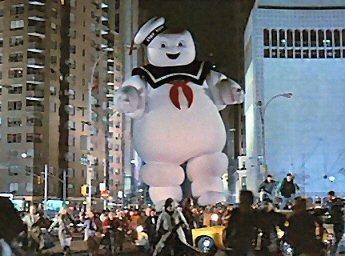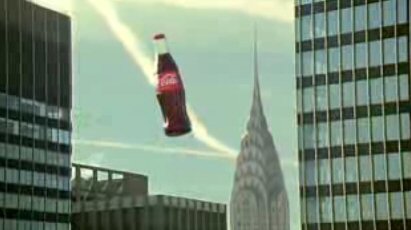Here in the USA, it’s Thanksgiving morning. The annual Macy’s Thanksgiving Day Parade in NYC is just getting started, and while I’ve never been a fan of parades, one can’t deny their significance in both small town culture and in big city holiday fests, alike. The news media treat them like spectator sports. For the event in NYC, millions attend — and millions more watch on television.
The spectacle of the parade “float” has always amused me. There are many variations and technologies put into practice for these objects, from novelty floats to “balloonicles” — and many of them are fictional characters from animation history, appealing to children; chief among them are animal figures, simulacra of the actual animals which used to be carted down the street (ala circus parade). The aesthetic of “balloon animals” sends us back to our childhood, here returned larger than life and, often, animistically empowered.
Which is another way of saying that these moving platforms and inflated creatures don’t merely “parade” down the street: they spectrally float, seemingly on their own accord, and their creators do all they can to hide the mechanics that move them. Parade floats and balloons glide down main street, like stages built upon magic carpets or gigantic ghosts. The spectrality of the parade float is what lurks behind the laughable logic of the possessed Stay Puft Marshmallow Man (pictured above) who attacks Dan Ackroyd and crew in the horror-comedy, Ghostbusters (1984). Parades command attention because of the communal fascination with public spectacles, and the human feats of greatness (from celebrities to heroes to marching bands) compete against spectacles of technological wonder and art. Parade floats are in every way an exhibition of the popular uncanny.
I first began thinking seriously about this notion during an ad I witnessed at the movie theater last week: a rerun of the following Coca Cola Ad aired during the 2008 Super Bowl:
In this advertisement, cartoon characters (Stewie Griffin and Underdog) virtually fistfight over a Coke bottle, careening against buildings and bouncing off one another in ways that look “realistic” — yet also impossibly conscious of what they are doing. It is a neat trick of camera work and choreography (even if one assumes CGI is involved, the trickery is pretty savvy), lending the floats a sense of autonomy in their motivated quest to beat each other to the prize: a bottle of coke. A more peaceful and happy Charlie Brown comes almost out of nowhere to steal the bottle away from the distracted pair, his permanent grin expressing his glee. In the final frame, the Charlie “has a Coke and a smile.”
There’s a lot more going on here than first meets the eye. For instance, the ad uses a lot of “reaction shots” of human beings looking up to the sky or out of their skyscraper windows, which makes the constructed scene appear to be “really happening” in the city. One might even miss, in all of these reaction shots, the inside joke to fans of the Peanuts comic: right before Charlie Brown wins the day, a little brown-haired girl walks in the city park, looking up to the sky while holding a football, as if she was Lucy (known for pulling the ball away from Charlie just as he kicked at it — sending him flying in the air and landing flat on his back. This joke doesn’t just give give Charlie his wings — it elides the difference between human and non-human, real and imaginary, in the few seconds it appears on air. Film, of course, does this anyway: actors are not “really” there before us, but trace images, recorded in light and rendered larger than life.
Even more puzzling: the Coke bottle itself, a float, a commodity as big as the characters who seek it. Clearly it is far too much to consume in reality — yet they are driven to drink it. Unlike the other balloon creatures, it does not act in human ways, but instead seems to function more like a symbol that is preordained to magically find its way to Charlie’s hands. That is, it is a transcendent signifier for the commodity itself that they all represent.
This is all fantasy, framed to pitch a product by processing cultural icons that include not only the floats, but also the “larger than life” setting of the city itself. There may be an uncanny echo of the Sept. 11th terrorist attacks operating in the political unconscious beneath this Coke advertisement. The “soft” bounce of these objects from childhood against skyscrapers may reflect a repressed fear of air attack on the city, here returned to the television screen as something akin to a childhood memory, a flight of animated fancy. The only people “threatened” by the horror of the giant balloons are those who aren’t paying attention to the spectacle in the streets, caught off guard. Perhaps I’m reading too much into the simple ad, but the imagery is striking.
The above image — appearing only for a second on the screen — seems to align Coke with the majesty of the city’s greatest icons. But it also implies so much more than that, especially given the context of “fighting” that it is embedded within. And in the image above, what are we to make of the clouds — the two lines like tracers of exhaust from two airplanes — arcing behind (or toward?) the Chrysler Building, while the shot as a whole is uncannily framed by two other “twin tower”-like buildings? I think it is patently obvious that this image is about fear as much as it is about fantasy.
One must wonder what the narrative of this ad might be saying about consumerism in relation to such cultural anxieties as global terrorism. Does it suggest something about competition, world trade, and terrorism? Is America the Charlie Brown, fooled by so many Lucies, so many wars? I’m not sure what it means, exactly, but I think there is some bottled up anxiety in this advertisement, felt as uncanny when it is uncapped and released.


1 comment on Parade Floats and the Uncanny